Problem-solving from a sparrow.
In some ways this isn’t a big deal because many of us see behaviors similar to this from birds fairly often. But it happens so fast and we’re usually so far away we can’t appreciate the steps and the details involved. Photography can allow us to see and appreciate them much better.
The first image has no catch light in the eye but I’m including it to help me tell the story. All photos are presented in the order they were taken.
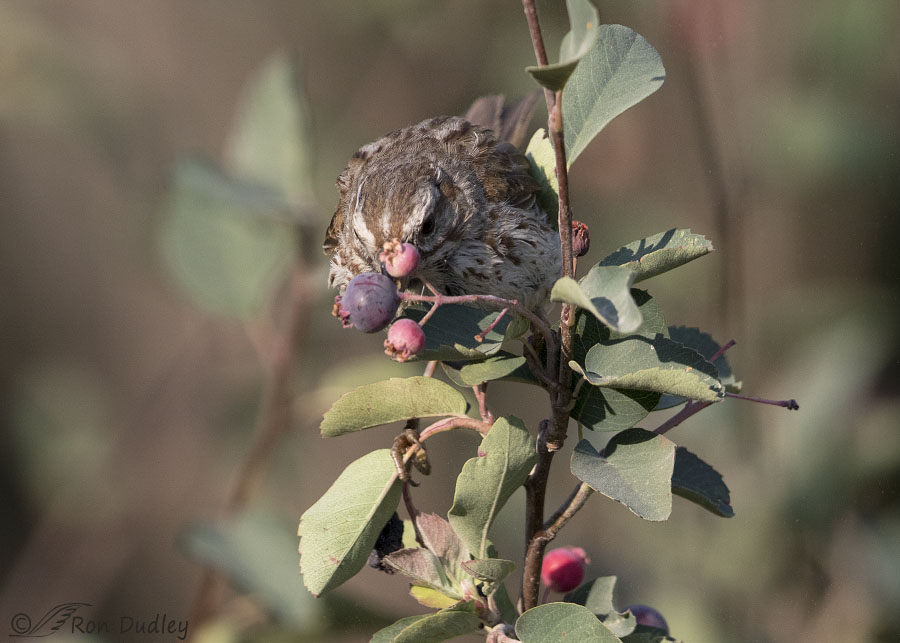
1/2500, f/6.3, ISO 800, Canon 7D Mark II, Canon EF 500mm f/4L IS II USM + EF 1.4 III Extender, not baited, set up or called in
Yesterday morning in the Wasatch Mountains this song sparrow had “his” eye on some serviceberries. One berry in particular, the ripe purple one. It was hanging nearly out of reach below him but he reached way down and grabbed it with the tip of his bill and then pulled it up in front of him where he hoped he could really work it over.
But it didn’t stay in that convenient spot for long.
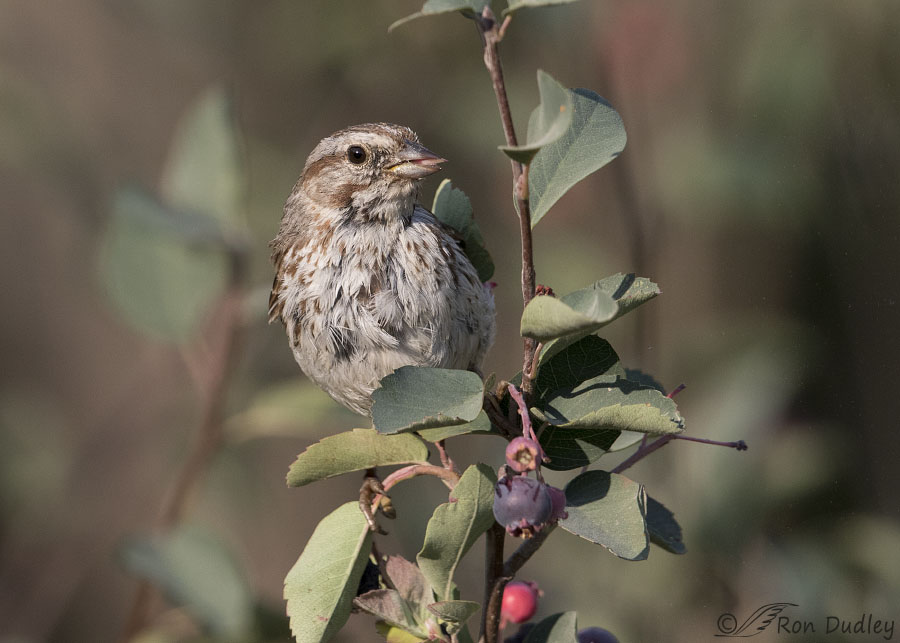
1/2500, f/6.3, ISO 800, Canon 7D Mark II, Canon EF 500mm f/4L IS II USM + EF 1.4 III Extender, not baited, set up or called in
As soon as he opened his bill slightly the berry dropped down to its original position while he was still licking his chops from the first tiny bite.
This technique just wasn’t going to get the job done.
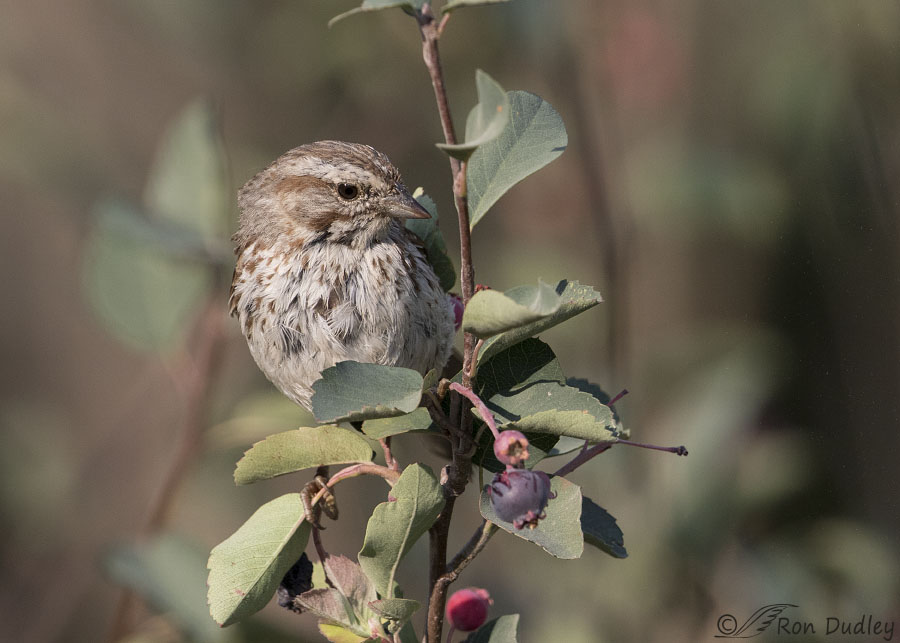
1/2500, f/6.3, ISO 800, Canon 7D Mark II, Canon EF 500mm f/4L IS II USM + EF 1.4 III Extender, not baited, set up or called in
So he pondered the berry and his predicament for a few moments and then changed tactics.
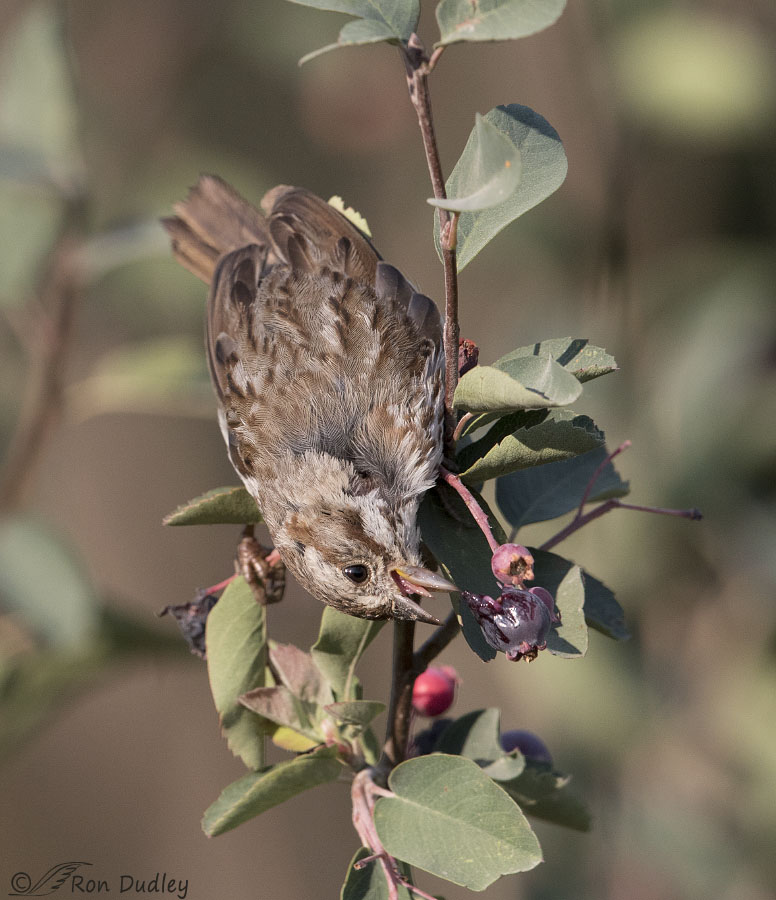
1/2500, f/6.3, ISO 800, Canon 7D Mark II, Canon EF 500mm f/4L IS II USM + EF 1.4 III Extender, not baited, set up or called in
He reached down to eat it in place, making no further attempts to retrieve it. It was an awkward position for him but at least the berry didn’t wander away while he was eating it.
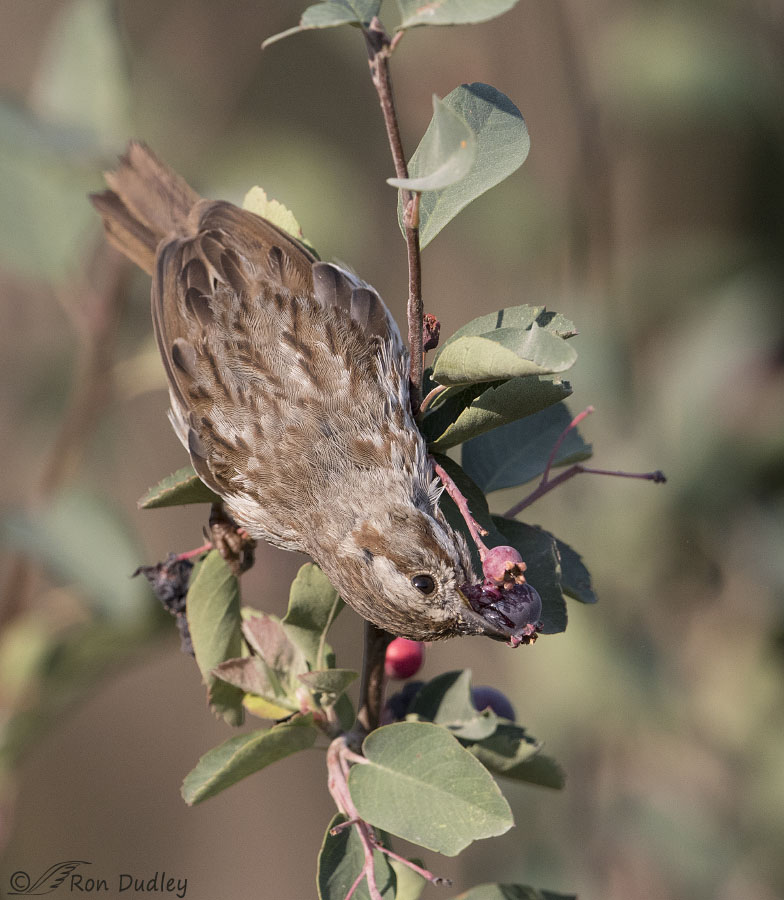
1/2000, f/6.3, ISO 800, Canon 7D Mark II, Canon EF 500mm f/4L IS II USM + EF 1.4 III Extender, not baited, set up or called in
He worked the berry over for a long time, occasionally getting a pretty good-sized chunk despite the lack of leverage he had.
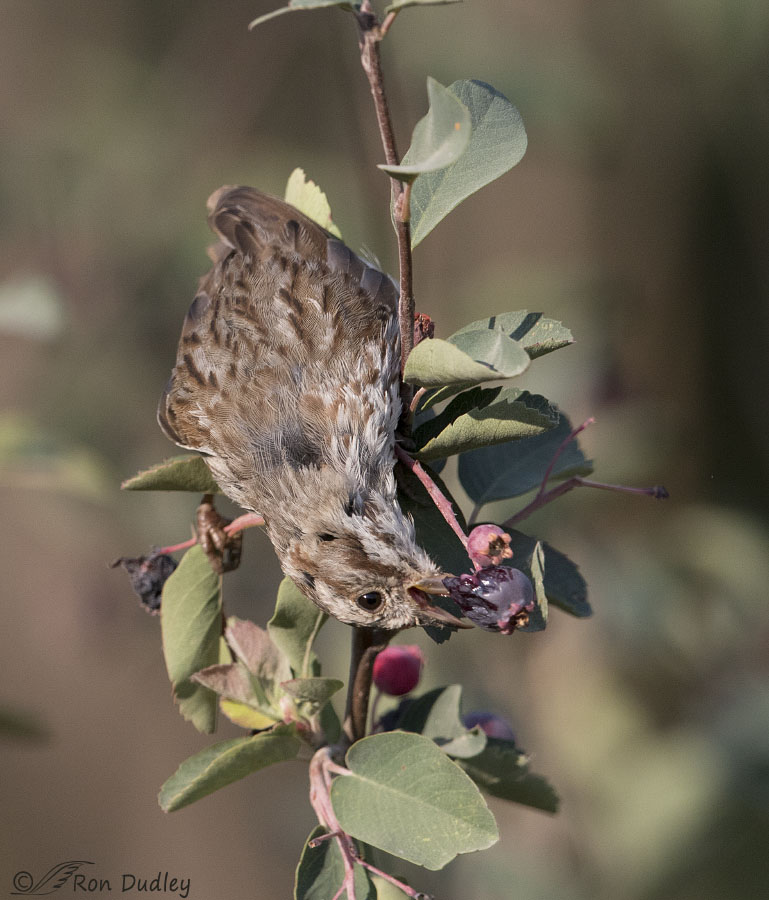
1/2500, f/6.3, ISO 800, Canon 7D Mark II, Canon EF 500mm f/4L IS II USM + EF 1.4 III Extender, not baited, set up or called in
Occasionally he rotated his head so far it was completely upside down for this upside down body position. You may have as hard a time orienting yourself as to his actual head position as I did. If so, notice in the second and third photos that his whitest eye stripe is directly above his eye when he’s right side up but here it’s beneath the eye. The eye we see is his left eye and his slightly curved upper mandible is at the bottom.
It makes my neck hurt and my eyes water just to look at this photo.
I simply cannot believe the bounty of berries in the mountains this year and the birds are taking full advantage. My personal friend and fellow photographer Neil Rossmiller described it best on one of his recent Facebook posts. Neil lives in the Wasatch Mountains and he pays close attention to such things so he knows what he’s talking about. Here’s what he said:
- “The bounty of this years berry crop defies logic. Last year we lost everything due to a late freeze. There weren’t any Service Berries, Choke Cherries or Hawthorn berries. No Acorns either. This year, even though we are drier, we are having a bumper crop of all the above. The stored energy is pretty remarkable.”
Just this week friend and blog follower Tana Peery Hunter made chokecherry jam. I don’t know how much she made but I suspect it was a substantial amount because she described the process as a “PITA” on Facebook. Judy Gusick who comments here often said a couple of days ago that chokecherries “are berries that will make a helluva mess on vehicles/concrete/hands. MUST use gloves working with them or they’ll show until new skin grows out”. Perhaps that was part of Tana’s trouble with them. I’ll have to check out her hands for chokecherry stains next time I see her…
It’s a good year for the berry-eating birds and my berry-eating friends.
Ron
Addendum: I’m getting questions about the meaning of “PITA”. For my slightly more sheltered readers PITA = “pain in the ass”. You just never know what you might learn here on Feathered Photography. 🙂


Smart bird! Do you know that service berries make great ‘blueberry’ bread, cakes and muffins? That is, if you can beat the birds to the fruit. I have five service berry trees in my suburban yard. The robins love it.
Late to the party today. Thank you for explaining PITA (I think of it as a flatbread…) Definitely not up on texting terms. I’m not sheltered, just old. I love that you captured the creativity of the Sparrow. Clearly the berries were a great motivator. I’m also glad to know that there is a glut of berries, that the birds and other critters have enough to eat this year.
“I think of it as a flatbread”
I didn’t even think of that possibility, Susan. Yes, I guess it is a good thing I explained it at the end.
I did also Susan. 🤪 I couldn’t understand what that had to do with the thing ! I missed the explanation first time around.
Kathy, I didn’t add the explanation until perhaps a half hour after I published the post. That may be why you “missed it”.
He clearly seems to be sizing up the situation in frames 2 and 3…so much for birds not problem-solving, or that problem-solving is only a human trait…BS!!! (Humans are definitely better at CAUSING problems, though!). By the end of next week, we will have had about three weeks straight of rain…have you had a lot, too…and if so, is it why you have a bumper crop of berries???
…
A lot of rain? Hell no, we haven’t had any to speak of for months. Dry as a bone, fires and smoke everywhere. It’s depressing and unhealthy.
I do love your behavioural series. So much. Thank you.
Thanks, EC.
Very fun post! I’ve learned so much from photographing birds. I see what they’re doing so much clearer when I get home from a shoot going through the photos! Thanks for showing these
Yup, they’re teaching me all the time, Joanne. Thanks.
I love this series for many reasons, but primarily because it clearly illustrates birds’ problem-solving skills. They do ponder and consider, figuring out how to do what they need to do better. And while so many humans would dismiss their intelligence, well, they just need to STOP that! We’re so much more alike than we are different.
Given how stiff my body has become, that neck thing makes me cringe, but the reality is I couldn’t have done that even when I was young and supple. I don’t have enough vertebra to do that. Sigh! LOL!!
Thank you for providing yet another behavioral series. I love those!!
“I don’t have enough vertebra to do that”
I don’t either, Laura. Never did…
Oh yes. Birds do think. And plan.
Echoing Laura’s comments about their dexterity too. S’not fair. Birds have rather a lot of things I would love. Flying is just the first..
Yeah, feathers come next. They’re a biggie. MUCH better than this straight and stringy hair I’ve got! Jeesh, the human design flaws are numerous 🙂
These are fun shots, love the behavior and the post. Interesting, our blueberries have been out and are just starting to go by and the birds simply just peck at them. However, once the waxwing find them they will take the whole berry.
Ah when life was slower, hearty meals and smells radiated from the open kitchen window. Homemade preserves, jams – WOW, what memories we all have!!
Thanks, Dick. There’s definitely some truth to the saying “the good old days”.
Delightful photos and commentary. Thank you, Ron.
Thanks, Melanie.
I love these shots. Colorful, colors contrast and are bright, sharp and clear, real life action, intimate, make the viewer root for the bird. #4 rocks me. Good stuff. Thanks!
Thanks very much, Martha. I love to “rock” my readers… 🙂
PS The hawk doesn’t literally have a long beak. I keep her neatly coped. She’s 29 this year and hasn’t had a sick day in the 17 years she’s lived with me. She’s blind in one eye, however, and an imprint and so unable to be released.
No sickness in that many years – that’s remarkable.
I have a sour cherry tree right over a cage with an educational Red-tailed Hawk living in it. The birds love the sour cherries, but for years wouldn’t get them all because they were wary of the hawk. This year however they persisted, thinking no doubt that the hawk lady is getting long in the tooth (beak), which, at 29, she is. The grosbeaks and robins ate every cherry except one that is still hanging low by the hawk’s low perch. Their technique is to eat the meat off all the stones and leave the bare stones hanging, like little dull Christmas balls. Thanks to this series of photos, I can see how they did that!
Wow, your red-tail has lived a long life, Sallie!
I’m glad the photos helped you appreciate what birds often go through to eat berries. Birds like waxwings who eat them whole have it easier.
“My” redtail, who is no more mine than the air I breathe, is 25 this year. She’s also blind in one eye, and while I didn’t think the blindness in itself was that much of a barrier to getting her back out in the field (despite the challenge of flushing prey only to her sighted side), she’s also got some neurological damage that causes extreme clumsiness periodically and that IS a problem. That said, other than her three hunting injuries, she’s never been sick, either. Like you Sallie, I’m pretty proud of that. I don’t have many jobs in falconry, but feeding good food, keeping the mews clean with a never-ending supply of clean water and good air flow is my big job. I like to be good at it.
Ron, no way I could have oriented the bird without your instructions. WhenI got it my neck hurt too. Such persistence. The berries must really be tasty. Thanks. Diana
It took me a while to figure it out too, Diana. The eye stripe and the curved upper mandible helped.
Amazing ‘bird logic’! More amazing agility! That little one makes one’s mouth just water looking at the juice on that berry. These are great catches. I find it interesting to see the serviceberries; the ones in my yard were long gone by the end of June. Goes to show the provenance of a tree makes a big difference in what happens to it in it’s growth cycle.
“Goes to show the provenance of a tree makes a big difference in what happens to it in it’s growth cycle”
Exactly, Kathy. These serviceberries are at about 6500′ and that makes a difference.
Remarkable photos– if we humans had to maneuver this diligently for every mouthful, there’d be far fewer of us with overweight problems. When I was a child, a friend’s grandmother
used to treat us to her homemade chokecherry jam ( she lived in the Bear Lake region of northern Utah ) on her also homemade soft rolls–divine ! I’ve never forgotten the taste of that jam !
Good point about humans having to do this, Kris.
And your statement about your friend’s grandmother reminded me of my own and the luscious smells from her old fashioned kitchen in Alberta in the early 50’s as she was making homemade bread and cinnamon rolls. My mouth is watering…